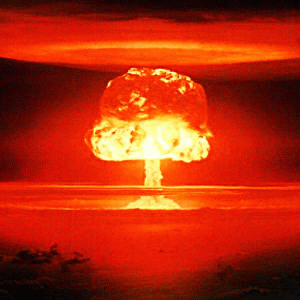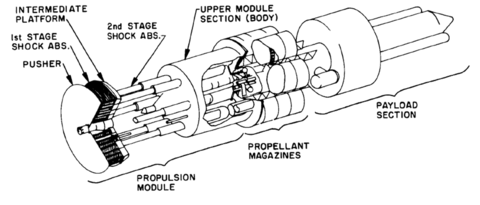Project Orion

One of the biggest issues holding mankind back from exploring the cosmos is the reality that it will take a huge investment of time to travel the huge distances between planets and stars. Using current space technology it would 81,000 years to traverse 4.2 light years between Earth and Alpha Centauri, the nearest star system to our Sun.
In the late 1950s Freeman Dyson, a gifted mathematician and physicist was approached by General Atomics to develop a truly fascinating type of spacecraft propulsion.
The Orion Project was the idea to drop a series of atomic bombs behind a spacecraft and allow the momentum of the blast to propel the vehicle. The blast wave is caught by a thick steel plate which forms the rear of the spacecraft, the plate slams the vehicle forward. Moments later another bomb is ejected and the process is repeated. Each aditional detonation adds to the spacecraft's velocity until the spacecraft reaches its cruise velocity.
"So we would launch the ship into space - bomb, bomb, bomb, bomb, bomb - going up about four bombs per second" - Freeman Dyson
Dyson considered two spacecraft designs. A more conservative spacecraft, would use a energy limited pusher plate that could absorb all of the thermal energy from each nuclear blast without melting. The exposed surface of the plate would be coated in copper. 100 seconds would be required to give the plate enough time to cool down before the next explosion. This method would allow the Orion to carry a huge payload and travel at approximately 0.3% of the speed of light, arriving at Alpha Centauri in about 1000 years. The second design that was considered, was the momentum limited pusher plate design. The design required an ablation coating of the exposed surface of the pusher plate, which would cool down considerably quicker than the aforementioned method. With this design the spacecraft would be able to detonate an atom bomb every 3 seconds. The spacecraft would be considerably smaller, however it would be able to reach a velocity closer to 3% of the speed light, cutting down a journey to Alpha Centauri to an impressive 130 years.

So what happened to the Orion Project. Concerns over potential fallout from the nuclear bomb powered propulsion along with The Partial Test Ban Treaty (PTSB) of 1963 effectively put an end to the realisation of the Orion Project. The PTSB is a treaty banning nuclear tests in the atmosphere, outer space and under water.
We can only speculate how the Orion Project may have impacted space exploration if it was fully realised and progressd from the concept stage. Perhaps at a minimum we would be making trips to Mars and the moons of Saturn.
Hi Mark, this is a really interesting read!
Thanks @goodyear23